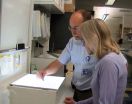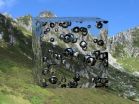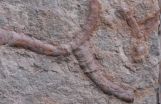SLU research finds enzyme inhibitors suppress herpes simplex virus replication
Investigators find different mechanism to fight herpes virus from what is currently on the market
2014-12-18
(Press-News.org) ST. LOUIS - Saint Louis University research findings published in the December issue of Antimicrobial Agents and Chemotherapy report a family of molecules known as nucleotidyltransferase superfamily (NTS) enzyme inhibitors are promising candidates for new herpes virus treatments.
The findings could lead to new treatment options for herpes that patients can use in conjunction with or instead of currently approved anti-viral medications like Acyclovir. Researcher Lynda A. Morrison Ph.D., professor of Molecular Microbiology and Immunology at Saint Louis University, likened a combination of treatments for herpes to a cocktail of medications HIV patients take.
"Acyclovir does a good job in suppressing the virus," Morrison said. "But because NTS inhibitors work by a different mechanism than currently approved drugs, we have the potential to have a drug that would work in combination with drugs that are already available to completely suppress the virus."
Lead author John E. Tavis, Ph.D., professor of Molecular Microbiology and Immunology at Saint Louis University, noted the findings, which first appeared online in September, have already received interest from pharmacology firms.
"Within a decade or so, we could have therapies that reasonably improve patient outcomes," Tavis said. "Improved outcomes could range from shorter duration of nuisance outbreaks (including cold sores) to a better treatment for herpetic encephalitis."
Herpes simplex virus (HSV)encephalitis is thought to occur from direct transmission of the virus to the brain via the nerves that transmit one's sense of sight or facial motor functions like chewing or biting.
The study's authors note that more than half of all Americans are impacted by cold sores (HSV-1) and 20 percent suffer from genital herpes (HSV-2). Herpes can be passed from mother to child during childbirth posing serious health risks to both the baby and the new mother. HSV-2 also increases the risk of human immunodeficiency virus (HIV) acquisition.
The research team at Saint Louis University investigated whether inhibitors of NTS enzymes would suppress replication of HSV-1 and HSV-2. The inhibitors suppressed accumulation of viral genomes and infectious particles and blocked events in the viral replication cycle before and during viral DNA replication.
Five of six NTS inhibitors of the HSVs also blocked replication of another herpes virus pathogen, human cytomegalovirus.
Tavis added that the team is now focused on expanding their original small scale study to identify the exact mechanisms by which each inhibitor suppresses virus replication. He noted that one compound has already proven effective in animals and another is found in a topical antifungal already FDA approved for use.
Researchers will also look at the evolution of the virus as it interacts with the inhibitors identified in the study.
"The hope is that it evolves really slowly," Tavis said. "That gives us a better chance at something that can work for a long time without allowing the virus to mutate as rapidly as currently approved treatments do."
Current treatment of herpes infections relies primarily on nucleoside analog inhibitors of the viral DNA polymerase, according to the article. Several newer agents are in clinical development, but none of them have been shown to fully suppress herpes infections.
INFORMATION:
Other authors include Hong Wang, Ann E. Tollefson, Baoling Ying, Maria Korom, Xiaohong Cheng, Feng Cao, Katie L. Davis and William S.M. Wold of the Department of Molecular Microbiology and Immunology at Saint Louis University School of Medicine.
Morrison and Tavis hold a U.S. patent application that covers the inhibitors they investigated.
The work was funded by seed grants from the Saint Louis University Department of Molecular Microbiology and Immunology, the Friends of the Saint Louis University Liver Center and the Saint Louis University School of Medicine.
Established in 1836, Saint Louis University School of Medicine has the distinction of awarding the first medical degree west of the Mississippi River. The school educates physicians and biomedical scientists, conducts medical research, and provides health care on a local, national and international level. Research at the school seeks new cures and treatments in five key areas: infectious disease, liver disease, cancer, heart/lung disease, and aging and brain disorders.
[Attachments] See images for this press release:

ELSE PRESS RELEASES FROM THIS DATE:
2014-12-18
Why are older people at higher risk for developing cancer? Prevailing opinion holds that, over time, your body's cells accumulate DNA damage and that eventually this damage catches up with the body in a way that causes cancer. A University of Colorado Cancer Center study published today in the journal Aging shows that this prevailing opinion is incomplete. In addition to DNA damage, cancer depends on the slow degradation of tissue that surrounds cancer cells, something that naturally comes with aging.
"It's really all about natural selection and survival of the fittest," ...
2014-12-18
Illinois is the most critical hub in the network of U.S. domestic food transfers, according to a new study by Megan Konar, an assistant professor of civil and environmental engineering, and colleagues at the University of Illinois at Urbana-Champaign. The study was published in the journal Environmental Science and Technology.
Much like the national airport network in which O'Hare International Airport is a major hub, Illinois plays the most central role in distributing food across the U.S. According to the report, the U.S. food network moves more than 400 million tons ...
2014-12-18
Doctors and nurses are traditionally thought to be the primary caretakers of patients in a typical hospital setting. But according to a study at the burn center intensive care unit at Loyola University Health System, three physicians, a social worker and a dietitian were documented as the most central communicators of the patient clinical team.
David Shoham, PhD, and colleagues were published in the American Burn Association's Journal of Burn Care & Research. Shoham is an associate professor in the Department of Public Health Sciences of Loyola University Chicago Stritch ...
2014-12-18
Chicago, December 17, 2014--A poll of the Russian public, conducted by The Associated Press-NORC Center for Public Affairs Research, was released today. The poll, which includes a nationally representative in-person survey of 2,008 Russian adults taken between November 22 and December 7, 2014, found that President Vladimir Putin is extremely popular. Few say the economy is in good condition and most say that sanctions are hurting the Russian economy. Despite economic woes, most Russians believe their country is headed in the right direction. Most respondents are also optimistic ...
2014-12-18
WASHINGTON, D.C., December 18, 2014 -- Uncork a bottle of champagne, and as the pressure of the liquid is abruptly removed, bubbles immediately form and then rapidly begin the process of "coarsening," in which larger bubbles grow at the expense of smaller ones.
This fundamental nonequilibrium phenomenon is known as "Ostwald ripening," and though it is most familiar for its role in bubbly beverages, it is also seen in a wide range of scientific systems including spin systems, foams and metallic alloys.
On a much larger scale, Ostwald ripening can be observed in a power-generating ...
2014-12-18
Cilia, the cell's tails and antennas, are among the most important biological structures. They line our windpipe and sweep away all the junk we inhale; they help us see, smell and reproduce. When a mutation disrupts the function or structure of cilia, the effects on the human body are devastating and sometimes lethal.
The challenge in diagnosing, studying and treating these genetic disorders, called ciliopathies, is the small size of cilia -- about 500-times thinner than a piece of paper. It's been difficult to examine them in molecular detail until now.
Professor ...
2014-12-18
COLUMBIA, Mo. - A new study from University of Missouri and Virginia Tech researchers is challenging accepted ideas about how ancient soft-bodied organisms become part of the fossil record. Findings suggest that bacteria involved in the decay of those organisms play an active role in how fossils are formed--often in a matter of just a few tens to hundreds of years. Understanding the relationship between decay and fossilization will inform future study and help researchers interpret fossils in a new way.
"The vast majority of the fossil record is composed of bones and ...
2014-12-18
New Rochelle, NY, December 18, 2014--Internet addiction is an impulse-control problem marked by an inability to inhibit Internet use, which can adversely affect a person's life, including their health and interpersonal relationships. The prevalence of Internet addiction varies among regions around the world, as shown by data from more than 89,000 individuals in 31 countries analyzed for a study published in Cyberpsychology, Behavior, and Social Networking, a peer-reviewed journal from Mary Ann Liebert, Inc., publishers. The article is available free on the Cyberpsychology, ...
2014-12-18
Health care systems and providers are not attuned to older adults' malnutrition risk, and ignoring malnutrition exacts a toll on hospitals, patients, and payers, according to the latest issue of the What's Hot newsletter from The Gerontological Society of America (GSA).
Under the title "Aging Policy: Preventing and Treating Malnutrition to Improve Health and Reduce Costs," the new installment points out that aging is a risk factor for malnutrition and highlights opportunities to improve nutrition awareness, interventions, and policy priorities.
Support for the publication ...
2014-12-18
To paraphrase Mark Twain, the report of the Kepler spacecraft's death was greatly exaggerated. Despite a malfunction that ended its primary mission in May 2013, Kepler is still alive and working. The evidence comes from the discovery of a new super-Earth using data collected during Kepler's "second life."
"Like a phoenix rising from the ashes, Kepler has been reborn and is continuing to make discoveries. Even better, the planet it found is ripe for follow-up studies," says lead author Andrew Vanderburg of the Harvard-Smithsonian Center for Astrophysics (CfA).
NASA's ...
LAST 30 PRESS RELEASES:
[Press-News.org] SLU research finds enzyme inhibitors suppress herpes simplex virus replication
Investigators find different mechanism to fight herpes virus from what is currently on the market




